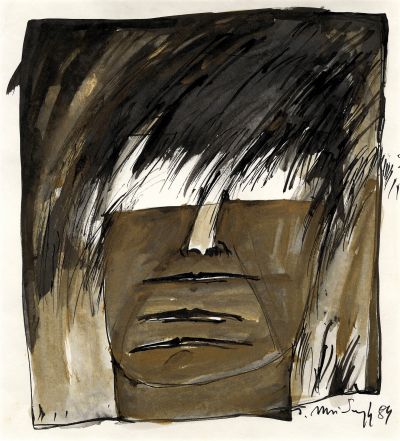Janina Musiałczyk. W drodze, on the road
Mediathek Sorted




































































































Shadows on the wall
“Christmas Eve. The wafer. On the big table, everything laid out as always, and a pineapple. I sit at the table for hours, drawing stones”. Three months previously, in October 1981, Janina Musiałczyk, her husband, and her daughter had moved once again into new, temporary accommodation, this time on the second floor of an apartment block in Hamburg-Steilshoop.
As the artist wrote in her book, “Drawings and Texts” (Rysunki i teksty. Zeichnungen und Texte), the buildings were more attractive than the ones on the Zgierska Stefana estate in Łódź, from where the family had departed in May 1981 on an odyssey first to Sweden, and from there to Germany. In this strange new world, it was a real comfort to share the apartment in Steilshoop with another family. Together, they were seven in all, “seven metal beds, seven pillows, seven blankets, seven bedsheets, seven chairs, one table and seven towels”. She spent many hours in the dining room with the pink, flowery wallpaper. Cockroaches scuttled across the kitchen floor at night. They were given a Christmas parcel from an unknown donor. On 13 December, the regime under General Jaruzelski had declared martial law in Poland. Since then, the family had listened day and night to programmes produced in Munich by the Polish section of Radio Free Europe.[1]
For Janina Musiałczyk, living spaces are a fundamental expression of human existence. Her parents’ apartment, rented rooms, temporary accommodation, and longer-term places of residence were dwellings and sanctuaries, while at the same time, they also acted as points of transition, as stations marking different periods in her life, or as places of refuge. In her mind, dwellings embody places of arrival and parting, of waiting for parents or a lover. They act as spaces for work and creativity, are an expression of social stagnation or steps towards affluence and happiness. Apartments become places of fear and change into spaces where celebrations are held. They radiate security and the hope for a better social and societal future. For the artist, places where she used to live become anchors of memory.
She begins the account of the journey through her life, which she wrote down in 2001 in Hamburg in her artist’s book “Drawings and Texts”, and which takes the reader from one place of abode to the next, in 1946, in a rear courtyard building in Pabianice, Poland. At that time, she was three years old, and her grandmother lay dying on the bed in the middle of the room under a white blanket.[2]
The following year, the family returned to Łódź, to ul. Bednarska: “Fourth floor, room with kitchen. Across the hall on the same floor, the laundry room with a huge vat for white boil washes. [...] I am alone at home ... I force myself into the gap between the stove and the wall and wait until my parents return home from work. On Saturday, after the big laundry wash, the bath. First Ela, then me, we climb up into the huge vat and wallow in the warm water”.[3]
Soon after, the family moved again. In 1948, they lived in ul. Dygasińskiego: “Ground floor, two long through-rooms and a small, square-cut kitchen. [...] From the bedroom window, you can see the house on ul. Bednarska, a red dressing gown hanging from the chimney. It’s a woman who took her own life. [...] In this apartment, it feels cramped. I look for a space to call my own”.[4]
In 1964, Janina, now an adult of 20 or 21, moved into the vacated room of an apartment occupied by a school friend. The following year, she switched to a small, bright room rented out by two elderly ladies. By then, she had been studying at the Art Academy in Łódź for eight semesters. At night, she designed silk shoulder cloths for a company that produced scarves, shoulder cloths, and ties. On weekends, her fiancé came to visit from Warsaw. The following year, they both sub-rented an eight metre-square room with a shared kitchen and bathroom not far from the park in the old town: “The cupboard, the sofa, the small table, two chairs and sheets of paper, rollers, canvases, paints, brushes”.[5]
In 1967, they moved a few streets further down, into their first proper apartment: “We paint everything dark blue: the small, square table, the armchairs, the cupboard in the hallway, even the doors and windows. [...] Here, in these 21 square metres, I complete my diploma, sell my first painting. We have parties here. Joanna brings big platters of hors d’oeuvres from the Grand Hotel”.[6] Soon afterwards, her daughter was born.
[1] Janina Musiałczyk: Rysunki i teksty. Zeichnungen und Texte, typography: Iga Bielejec, self-published, Hamburg 2001, page 36.
[2] Ibid., page 4.
[3] Ibid., page 6.
[4] Ibid., page 8.
[5] Ibid., page 14.
[6] Ibid., page 16.





















































































